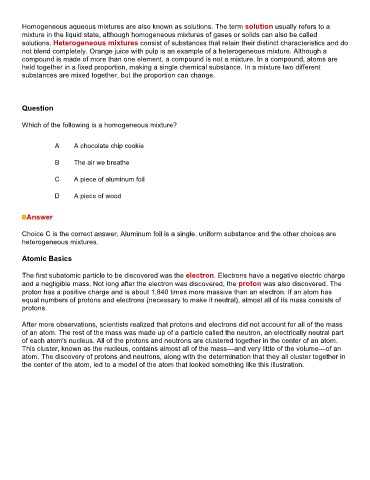Page 332 - ABCTE Study Guide_Neat
P. 332
Homogeneous aqueous mixtures are also known as solutions. The term solution usually refers to a
mixture in the liquid state, although homogeneous mixtures of gases or solids can also be called
solutions. Heterogeneous mixtures consist of substances that retain their distinct characteristics and do
not blend completely. Orange juice with pulp is an example of a heterogeneous mixture. Although a
compound is made of more than one element, a compound is not a mixture. In a compound, atoms are
held together in a fixed proportion, making a single chemical substance. In a mixture two different
substances are mixed together, but the proportion can change.
Question
Which of the following is a homogeneous mixture?
A A chocolate chip cookie
B The air we breathe
C A piece of aluminum foil
D A piece of wood
Answer
Choice C is the correct answer. Aluminum foil is a single, uniform substance and the other choices are
heterogeneous mixtures.
Atomic Basics
The first subatomic particle to be discovered was the electron. Electrons have a negative electric charge
and a negligible mass. Not long after the electron was discovered, the proton was also discovered. The
proton has a positive charge and is about 1,840 times more massive than an electron. If an atom has
equal numbers of protons and electrons (necessary to make it neutral), almost all of its mass consists of
protons.
After more observations, scientists realized that protons and electrons did not account for all of the mass
of an atom. The rest of the mass was made up of a particle called the neutron, an electrically neutral part
of each atom's nucleus. All of the protons and neutrons are clustered together in the center of an atom.
This cluster, known as the nucleus, contains almost all of the mass—and very little of the volume—of an
atom. The discovery of protons and neutrons, along with the determination that they all cluster together in
the center of the atom, led to a model of the atom that looked something like this illustration.

